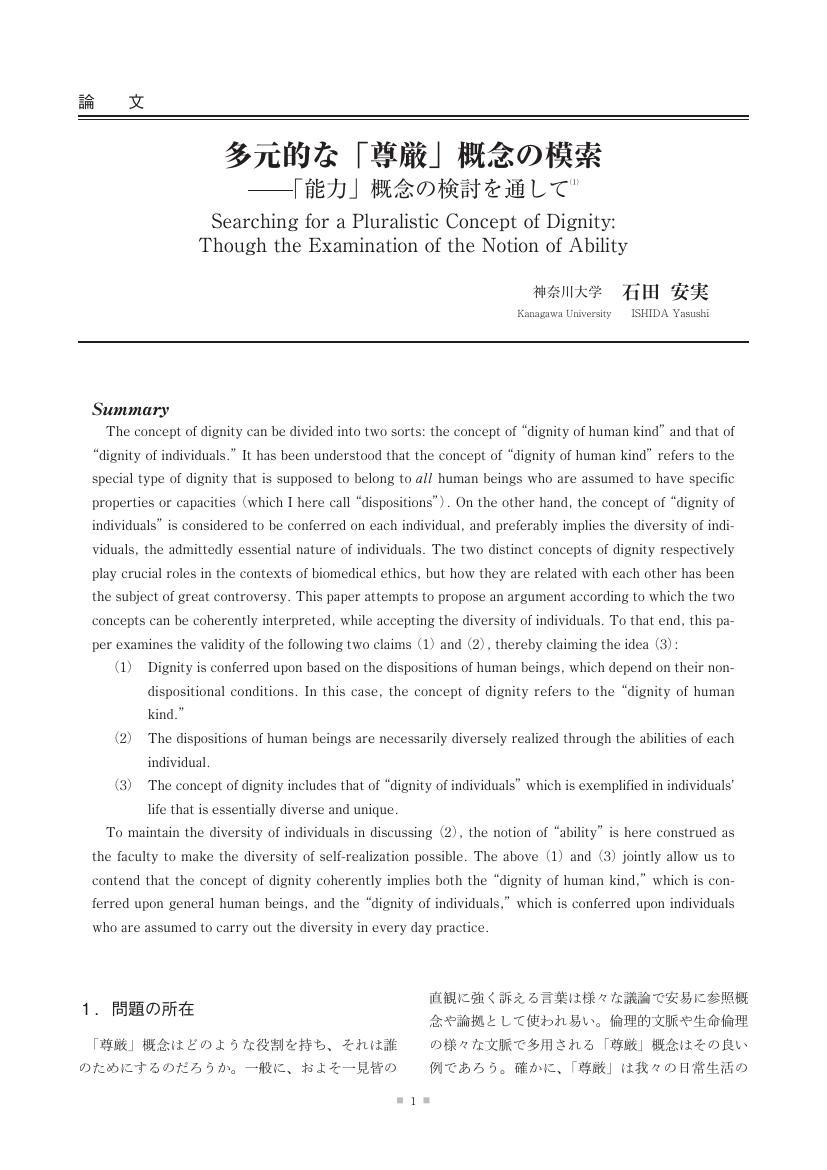8 0 0 0 OA 「尊厳」は役に立たないか:多元的社会のための「尊厳」概念 英語圏の議論を中心に
- 著者
- 石田 安実
- 出版者
- 日本医学哲学・倫理学会
- 雑誌
- 医学哲学 医学倫理 (ISSN:02896427)
- 巻号頁・発行日
- vol.34, pp.32, 2016 (Released:2018-05-07)
2 0 0 0 OA 日本における「正常さ」概念 生命倫理学の観点から
- 著者
- 石田 安実
- 出版者
- 日本医学哲学・倫理学会
- 雑誌
- 医学哲学 医学倫理 (ISSN:02896427)
- 巻号頁・発行日
- vol.34, pp.83, 2016 (Released:2018-05-07)
- 著者
- 石田 安実
- 出版者
- 日本医学哲学・倫理学会
- 雑誌
- 医学哲学 医学倫理 (ISSN:02896427)
- 巻号頁・発行日
- vol.39, pp.11-21, 2022 (Released:2022-08-12)
1 0 0 0 OA 「自律」の新たな「弱い実質的説明」ー「正常さ」概念の検討を通して
- 著者
- 石田 安実
- 出版者
- 日本医学哲学・倫理学会
- 雑誌
- 医学哲学 医学倫理 (ISSN:02896427)
- 巻号頁・発行日
- vol.37, pp.1-13, 2019 (Released:2022-07-20)
1 0 0 0 OA 多元的な「尊厳」概念の模索 「能力」概念の検討を通して
- 著者
- 石田 安実
- 出版者
- 日本医学哲学・倫理学会
- 雑誌
- 医学哲学 医学倫理 (ISSN:02896427)
- 巻号頁・発行日
- vol.35, pp.1, 2017 (Released:2018-06-20)
1 0 0 0 OA IC における「会話モデル」を補うもの
- 著者
- 石田 安実
- 出版者
- 日本医学哲学・倫理学会
- 雑誌
- 医学哲学 医学倫理 (ISSN:02896427)
- 巻号頁・発行日
- vol.31, pp.22-32, 2013 (Released:2018-02-01)
In recent years, in discussing informed consent obtained between a doctor and a patient, we normally endorse the so-called“ conversation model” over the“ information disclosure model” ― for good reason. The advantages of the“ conversation model,” which integrates two-way communication between a doctor and a patient, are that it pays much more respect to a patient’s autonomy and that the doctor can correct the patient’s misunderstanding during the process; they mark a distinction from the“ information disclosure model” which is based on simple one-way communication. Close examinations of the“ conversation model” reveal a hidden, essentially asymmetric relationship between a doctor and a patient, however. Furthermore, we can see that the model’s assumption that a patient is a“ reasonable person” who is always capable of making rational or reasonable judgments is not convincing at all, when we discuss patients who are rarely in a position in which they can give any reasonable thinking. It turns out that the model has several practical problems as well. Given the essential doctor-patient asymmetric relation, what do we need to apply the model in a more practical fashion? This paper attempts to give an answer to that question by examining Howard Brody’s“ transparency standard.” The standard makes the model meet practical and legal purposes required for actual medical practices, but appear to lead us to what I call“ moderate or liberal paternalism.”
1 0 0 0 「倫理判断のパッケージ化」 とその倫理的責任
<p> 現代では、医療やその制度が高度に発達し、患者は複雑に専門化した知識や情報を与えられるようになった。そうした中、患者たちは自己決定をしなくてはならない場合でも、「全き意味での自己決定」が前提とする「合理的判断能力のある個人」「十分な情報理解」「外的強制がない」というあり方ではなく、「十分な判断能力に欠ける個人」「情報の不十分な理解」「様々な事柄への配慮」をする個人として、制度という外部の「装置」に依存しながら倫理的判断を行うようになったといえる。その判断形態を、筆者は「倫理判断のパッケージ化」という概念で理解する。「全き意味での自己決定」ではなく「倫理判断のパッケージ化」に基づいて判断する者の倫理的責任は、どのようなものだろうか。筆者は、法的責任と倫理的責任を分け、前者を認めることで制度の有効性を維持するが、後者をより緩やかに取ることで、「倫理判断のパッケージ化」によって判断する者をより良い関係に取り込むことを提案する。</p>




